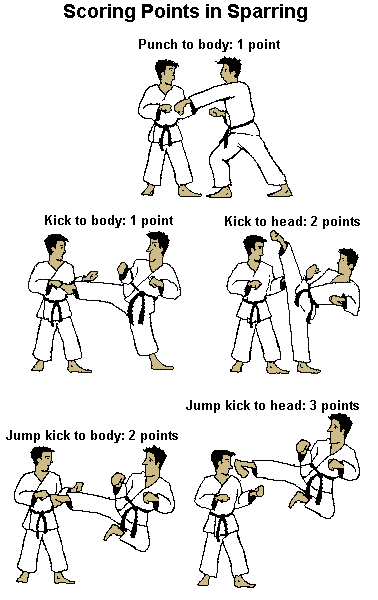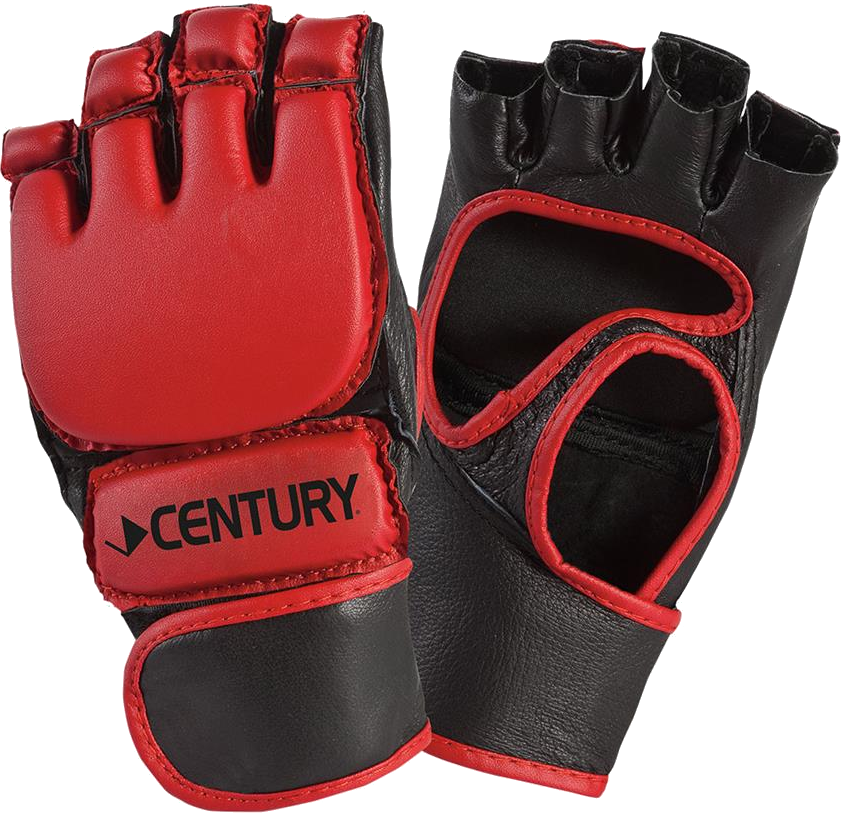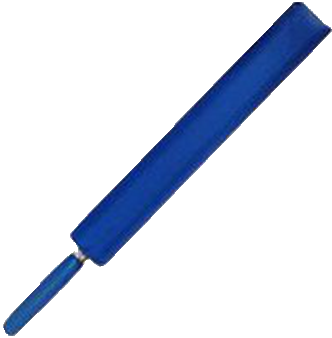Sparring: A Primer
In General
A traditional sparring match is over when one competitor earns 5 points within 2 minutes or is ahead after 2 minutes has elapsed. Should the score be tied after regular time expires, the competitors continue in "sudden victory," where the person who scores the next point wins the match. In combat sparring, one must earn 10 points to end the match early.
Be sure you read and understand the rules for traditional point sparring.
The judges are the ones who run the ring, calling points and warnings, and keeping the competitors safe. They do the best job they can with the views they have, watching two fast-moving people throwing kicks and punches at each other. Competitors and spectators should remember the judges only see small part of the sparring match at any instant. Spectators have different views, and they will often see things the judges do not. If there is a legitimate concern, feel free bring it to the attention of the tournament leader.
Safety
Safety is a top priority in sparring.
While sparring is ideally noncontact, contact does frequently happen. It's up to you, as a competitor, to ask the judge to keep the contact down if you feel it's too much.
Competitors must wear all appropriate and approved protective equipment. Guys, you know what this means. No, really: You will not be allowed to spar if you do not have all your protective equipment on. We are quite serious about this. In a tournament, competitors who don't have all their equipment will be given a few minutes to acquire and put on the appropriate gear and equipment. The sparrer's equipment inventory should be taken care of before they leave home for the tournament, or, at the latest, before the competition in their ring begins.
Competitors do not have to hit hard to score points. All they need to do is to show they can score. However, contact does occur. In color belt sparring, contact is not necessary to score points; it's only necessary to get close enough. Again, however, contact does occur.
If a competitor is hurt or stunned, the match will be stopped. If the competitor is under 18 years old, the explicit permission of the parent, instructor, and tournament is be needed for the sparrer to continue the match and the rest of the competition. If a competitor can't continue, they will not lose consideration for medals for places they've already earned, but they will be out of the rest of the tournament. If a hurt adult sparrer overrules the tournament medical person, the competitor's signed waiver must be found to indicate that they knew in advance the risks of an injury. A sparrer might not be in a good state of mind to make a good, informed decision immediately after the injury, especially if it's a blow to the head. This might sounds like it's a lot of fuss, but safety is the new watchword.
Etiquette
Our primary goal for its students in sparring matches is to be safe and have fun. To do that, competitors and spectators are to follow these rules and guidelines:
All sparring students are expected to wear approved equipment
- Head gear
- Face shield
- Chest guard
- Foot gear
- Hand gear
- Mouth guard
- Protective cup (for males)
Students and their parents will practice good sportsmanship by showing discipline, courtesy, and respect. They will refrain from signs of frustration, disgust, or dissatisfaction with the outcome of matches, and they will not show over-exuberance should they or their student win a match.
A student always has the right, and the responsibility, to limit the amount of contact during a sparring match. Although color belt sparring is ideally noncontact, contact does occur. If you are uncomfortable with the amount of contact or power, it is your right, and responsibility, for you to ask for less contact or power. No one else will ask for you.
Scoring
The diagram below shows how points are scored in a tournament.
The winner of a traditional sparring match is the competitor who is the first to earn five points or has the greater number of points at the end of two minutes. If the match is tied after two minutes, it enters "sudden victory": The competitor who gets the next point wins.
For a point or no point/block call to be made, a judge must observe the point (or block/no point). If the judge does not see the contact in question, he can call only "no see," even if it's obvious that contact was made. Judges must see the point they call.
Out of bounds: A sparrer can't score on their opponent for an attack when they're out of bounds. There are separate cases for punches and kicks:
- Punches: Both feet must be completely inside the ring when the punch lands
- Kicks: The base foot, or the last foot to leave the ground must have been in bounds
 |
 |
Techniques can't score if the competitor who executed the technique is falling during the strike or kick or falls immediately afterwards. For example, a jump round kick to the head - ostensibly a three-point shot - would be ruled as "no point" if the competitor does not cleanly land on only their feet. However, the point(s) will count if the reason the kicker (in this case) can't land cleanly is because of something their opponent does to knock them off balance.
Tigers
Tigers - boys and girls up to age 8 and competing as Tigers - participate in simplified sparring matches. Each competitor gets two sparring matches, each lasting 30 to 60 seconds. Each match is interrupted a couple of times, and although no points are awarded, each competitor is told about something good they did in that segment. Students must still wear a complete set of sparring gear.
Combat Sparring
Combat, or weapon, sparring adds a weapon to the sparrer's regimen. The structure of a combat sparring match is the same as that for a traditional sparring match, but there are four main differences:
- Equipment: Competitors use a special padded bahng mahng ee with special gloves
- Targets: The whole body (with a few exceptions, listed below) is a target
- Points: A strike can be worth more points, and the maximum number of points needed to win a match is higher. Also, one can have one knee touching the floor for a strike to count.
- Attacks: Punches and kicks are not allowed.
The idea behind combat sparring is what you (and/or your opponent) might do if one (or both) of you had a stick or pipe in your hand while fighting.
Be sure you understand the rules for combat/weapon sparring.
Equipment
| The same protective equipment is required for a combat sparring match as with a traditional sparring match: helmet, face shield, mouth guard, chest protector, kicks (foot pads), and male protective gear for the males. The difference is the gloves. For competition at regional, national, or world tournaments, competitors are encouraged to wear special combat sparring gloves. These are predominantly white; have the word "combat" printed on the back; and other than the fingertips, little padding on the inside. This design allows a good grip of the weapon while providing ample padding on the outside of the hand. In class or in in-school tournaments, your instructor may allow the use of your traditional sparring gloves (pull out your fingers from the glove grips for a better hold on the handle) or "bag gloves" (an older style of gloves which were used primarily for bag work). |

|

|
Weapon sparring is done with a specially padded bahng mahng ee. These are not the same ones which we train with in our standard classes. These bahng mahng ees are longer and are padded so a moderate-strength hit to a legal nonpadded body part will not cause serious injury. (If you try weapon sparring with a standard bahng mahng ee, it will hurt, so please don't.) They're basically nylon-covered pool noodles on sticks. A combat sparring stick must be in good condition: It must have no tears or holes in the fabric, the padding part of the weapon should not move along the stick, and the supporting stick inside the padded portion should completely fill the padding. |
Targets
Unlike in traditional sparring, where only the chest and head are targets, the entire body (with a few exceptions) is a target. A competitor's legs, arms, and back are all in play for points. Therefore one should avoid using their body to block attacks by their opponent because it probably will result in point(s) for your opponent.
The following are illegal targets in weapon sparring. The penalties in combat sparring for motions or strikes to illegal targets are the same as those for traditional sparring.
- All sides of the neck
- A horizontal strike to the eyes which might go through the hole in the sparring face shield
- The groin
A direct strike on a blocking body part would likely result in a point for the striker, a deflection does not count as a hit. For a strike to be deflected, the angle of the strike should not change appreciably. How much this is depends on the judges.
Points
The conditions which end of a weapon sparring match are the same as those which end a traditional sparring match save one: The maximum number of points in a combat sparring match is 10. (It's 5 points in traditional sparring.)
As mentioned earlier, the entire body (with a few exceptions) is a target. Except for the following strikes, all other (non-jump) strikes are worth 1 point:
- Head: 2 points
- The forearm of the hand which contains the weapon: 2 points
- A stab to the front leg: 2 points
As with traditional sparring, jumping adds a point. For example, a jumping head shot is 3 points (2 for the head + 1 for the jump); a jump strike to the back is 2 points (1 for the strike + 1 for the jump).
If the competitors strike each other simultaneously or nearly simultaneously, the point called is based on the judges' judgements. In these cases, the "lethalness" or "potential devastation" of the strike is not taken into account, nor is "continuation of motion" that has been considered in past years. For instance, a simultaneous strike on one sparrer's body and the other sparrer's head would not automatically be called for the head shot, being the worse one in a real fight.
There is one more important way that points can be scored: dropping the weapon. However, this works against you. That is, if you drop your weapon, it gives 1 point to your opponent. This is in addition to any points they might get from a strike they made on you. Here are some scenarios:
- You strike the weapon forearm of your opponent, which causes them to drop their weapon. You would earn three points for that: two for the strike and one for your opponent's weapon drop.
- You strike your opponent on the head, but in the act of striking, you lose control of your weapon and it goes flying. The score would be one point for your opponent for your weapon drop, and no points for you. In this instance, this is similar to not landing a jump in traditional sparring: You must maintain control through the attack.
- After you bow to the center judge and to each other, in the act of presenting arms, your weapon slips out of your hand. Even before any actual combat has occurred, this will result in one point for your opponent.
- You make a clean body strike on your opponent and hold on to your weapon. As the center judge is calling for points, you drop your weapon. This would result in one point for you for the clean strike, and one point for your opponent for your dropped weapon.
To expand on scenario 3, from the moment you bow in to the center judge until the match is ended, any drop of the weapon for any reason will result in a weapon-drop point for the other competitor.
You don't have to keep the weapon in the same hand. You are allowed to switch hands, but keep in mind, your opponent might use that against you: They might see that you're switching hands, choose then to attack, and cause you to lose concentration and drop your weapon. So if you do plan to change the hand the weapon is in, be careful.
When a weapon is dropped, one of the judges stops the match ("Stop time!"), makes a call for any weapon-drop points, then call for any hit/strike points. The match (and clock) is then restarted at the next face-off, if there is any time left.
Penalties

Safety first, always.
Warnings can (and often will) be issued to a competitor who uses excessive power, repeatedly runs out of the ring to escape an opponent's attacks, or feints or contacts an illegal target. This latter action (illegal contact) will likely result in a point for the other competitor.
Competitors will get warnings for these actions:
- Feint or attempted contact with an illegal target. The first time this happens will likely result in an oral warning, including a mention to not do that again or a warning point will be issued to their opponent.
- Actually contact to an illegal target. The first contact will result in a warning point for the offender. The second will disqualify that competitor from further competition in that bracket. There is a little gray area in here, which is explained below.
- Purposely running out of bounds to avoid the match or fall down to avoid contact or otherwise delaying a match. Going out of bounds or falling in the normal course of the match will sometimes happen. Competitors should know where they are in relation to the ring boundary. A warning will be issued to a competitor who does not engage in the match
- Grabbing or holding an opponent, but swatting or closed-hand blocking away kicks and punches is fine.
- Receiving coaching. Positive cheering is always welcome and encouraged. If a spectator is coaching by giving sparring advice, overt or coded, the chief judge will stop the match and remind them of the no-coaching rules. Should the coaching continue, the other competitor will receive warning points.
Competitors can be disqualified for contact warnings, but they can't be disqualified for noncontact warnings. However, after the first noncontact warning, the other competitor will receive points.
Here's some elaboration on the "actual contact" warning criterion: If contact to an illegal target is thought to be incidental and an attempt was made to avoid it, an oral warning might be given with an explanation. It's possible that no penalty point will be issued. For more blatant illegal moves, whether intentional or not, the first occurrence can result in an oral warning, unless contact was made, in which case a point will be awarded to the other competitor. The second occurrence of any illegal move is a point for the other competitor or disqualification if a point has been awarded already. The third occurrence of illegal contact in a match will cause that competitor to be disqualified from the rest of that event.
It is possible for a warning point to be issued to both competitors, but it's based on what the judges see. Here's one example: White punches red in the helmet, and simultaneously, red kicks white below the belt. The judges call "break!" and call for points, a warning call is thrown, the match time is stopped, and a conference ensues. The center judge will call first for the warning on red (awarding any point as necessary), then for the warning on white (awarding any points as necessary), then for points.
Sometimes, in the initial call for points after a break, a judge sees something that's a point but was seen as a warning by the other judges. When the center judge calls for warning points, the points-indicating judge must declare "no" or "disagree" because they thought what happened was a legal point. In the call for points immediately after the call for warning, that judge would indicate the point that they thought was scored. If a judge indicates a warning toward one sparrer, they can't also indicate a point earned by that sparrer in the same "call for warning / call for points" session.